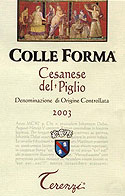I’ll Drink to That!
Imagine a medium bodied red wine, lovely to sip but crafted with enough bright acid to add zest to your meal. You identify a coalescence of red fruit, perhaps with pomegranate and some white pepper. The wine isn't too terribly tannic, great for non-cab lovers, but possessing decent weight and body nonetheless. Really tasty! Is your mouth watering yet? Too bad I am not in the business of reviewing wines. Not only is my own palate undistinguished and plebian but also my primary service to Bruliam is as the hooded Grand Marketing Inquisitor, the dark shadow lurking behind your neck chanting "buy my wine; buy my wine." On the other hand, if I do come across something cool or unusual, I will always share a glass with you, albeit virtually. As you already know, during my San Francisco excursion, I was lucky to drink something entirely new to me, the 2003 Terenzi "Colle Forma" Cesanese del Piglio, an Italian DOC wine from Latium, the region southeast of and encompassing Rome. Blessed with rolling hillsides, abundant sunshine and fertile volcanic soil, this south-costal area produces both reds and whites alike. To taste something akin to what I drank, look for bottles celebrating either the Cesanese Commune or Cesanese di Affile grape. Apparently, this rare wine is making a comeback, so who knows, perhaps you'll see one on a shelf at your favorite wine boutique sometime soon. For the record, the predominant grape variety in this wine is the Cesanese di Affile, a more richly flavored clone of the Cesanese Commune. While some Cesanese del Piglios are comprised 100% from this grape, Italian wine laws permits adulteration with other stuff, too. Per tradition, up to 10% of its composition may include other DOC sanctioned varietals including Sangiovese, Montepulciano, Barbera, Trebbiano toscano (Passerana) and Bombino bianco (Ottenese). The white wine is often added for acidity and aroma. Nectar of the Gods?
Per popular myth, this wine was the favorite of the Roman Caesars, professing quite a venerable pedigree for something I'd never heard of before. It is said to be the only grape indigenous to the area, and per my limited internet research, the grape isn't cultivated beyond this region either. Interestingly, Cesanese di Affile is said to be as difficult to grow as pinot noir, a loaded but worthwhile comparison. Actually the berry itself is rather small and thought to be more complexly flavored than its coarser, big-berried mama, the Cesanese Commune, not unlike the low yielding, small berries of our best pinot vines.
The particular wine we had, the 2003 Terenzi "Colle Forma" Cesanese del Piglio appears dedicated to local consumption, with only 330 cases allocated for US export. Even still, this very same wine showed up on another wine blog, Snooth, reviewed with a meal from yet another SF foodie institution SPQR. He said:
What an interesting wine, recommended with dinner by Shelly, the Sommelier at SPQR in San Francisco. Not too aggressive to sip while waiting for the antipasti - with which it paired perfectly. A little too hot to handle the very peppered Carbonara.
The wine is very pretty and shines brightly yet retaining a dark purple shade. A beautifully interesting nose reminiscent of Moroccan spiced carrots - with cinnamon and clove and caramelized sweetness leading into a very round mouthfeel full of broad black cherry fruit flavors. It is not quite flabby, but I would have liked the acids to fill my mouth. The chalky tannins and plum flavors rest on the mid tongue while the acids prickle and burn around on the finish.
Hungry for Hog?
Italian wine gurus suggest the ideal food parings to be hard cheeses, meat or game. In stark contrast, I paired mine with decadently creamy mozzarella burrata, salumi, and a kick ass, thin crust pizza. And you know what- it's all good. But my favorite morsel of Cesanese trivia is its unusual pork connection. Traditionally, this wine is racked early, like in November, rendered ready to imbibe all the sooner. In fact it is supposed to be available "when a hog is slaughtered and hams, "lonze" (cured fillet of pork), sausages and blood puddings are made."** How's that for culinary inspiration?
Here's to drinking something new!
Grape: 100% Cesanese d'Affile Vineyards: South-facing at 1,475 ft above sea level in Piglio, 305 cases per acre Vinification: Harvested by hand; light maceration for 25 days on the skins at controlled temperatures below 30°, in steel tanks Ageing: 10 mos, temperature-controlled, all stainless steel; finished in bottle circa 4 mos U.S. allocation: 330 cases Alcohol: 13% Service: 64-68° F
Orange-red in the glass, there's a scent of red berry and herbs on the nose, brandy-soaked cherries, and plum skins. Ideal with light sauces, red meat, roasted meat, and strong cheeses.
Sourced from:
http://zoliwine.wordpress.com/2007/12/22/romes-finest-red-grape-cesanese-di-affile/
**http://www.italianmade.com/wines/DOC10079.cfm
http://salviabianca.com/lazio.php

